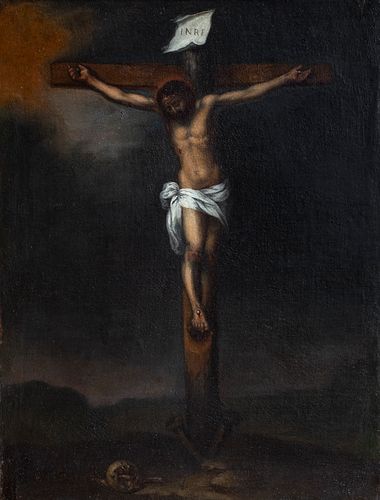Circle of BARTOLOMÉ ESTEBAN MURILLO (Seville, 1617 - Cadiz, 1682) "Christ Crucified". Oil on canvas.
Lot 61
About Seller
Setdart Auction House
Carrer Aragó 346
Barcelona
Spain
Setdart Subastas was born in 2004 and is currently the first online art auction in Spain with solidity, prestige and reliability guaranteed by our more than 60,000 users. Setdart has a young, dynamic and enterprising team ready to successfully manage the purchase and sale of art works through custom...Read more
Estimate:
EUR€5,000 - EUR€6,000
$5,376.34 - $6,451.61
Absentee vs Live bid
Two ways to bid:
- Leave a max absentee bid and the platform will bid on your behalf up to your maximum bid during the live auction.
- Bid live during the auction and your bids will be submitted real-time to the auctioneer.
Bid Increments
| Price | Bid Increment |
|---|---|
| EUR€0 | EUR€10 |
| EUR€200 | EUR€25 |
| EUR€500 | EUR€50 |
| EUR€1,000 | EUR€100 |
| EUR€3,000 | EUR€200 |
| EUR€5,000 | EUR€500 |
| EUR€10,000 | EUR€1,000 |
| EUR€20,000 | EUR€2,000 |
| EUR€50,000 | EUR€5,000 |
About Auction
By Setdart Auction House
Oct 20, 2021
Set Reminder
2021-10-20 07:30:00
2021-10-20 07:30:00
America/New_York
Bidsquare
Bidsquare : OLD MASTERS
https://www.bidsquare.com/auctions/setdart-auction-house/old-masters-7700
Setdart Auction House sofia@setdart.com
Setdart Auction House sofia@setdart.com
- Lot Description
Circle of BARTOLOMÉ ESTEBAN MURILLO (Seville, 1617 - Cadiz, 1682) "Christ Crucified". Oil on canvas. Period frame. Measures: 62 x 47 cm.; 71 x 54 cm. (frame). The figure of the dead Christ was very common in the Spanish Baroque iconography. Murillo made several versions in which, as in the important painting that we show here, the imposing image of the Crucified one is cut on a dark bottom of crepuscular lights in contrast with the powerful focus of light that models its powerful anatomy. It is a Christ with three nails, in which the master avoids excessive pathos and, on the contrary, prioritizes the atmospheric capture, the softness of the forms and the chromatic nuances, to procure a contemplative immersion of the believer. What is important is to highlight the magical moment in which humanity is redeemed by the suffering of the Savior. The composition, the bold iridescence of light and the rapid brushstroke In composition and language, this work is very close to Murillo's Cristo Crucificado (Christ Crucified) in the Prado Museum. The specialists have pointed out the influence of the Christ that Van Dyck painted for the church of Dendermonde. Dated around the year 1667, possibly purchased by the wife of Philip V, Isabel de Farnesio, appears in his collection in 1746, appearing documented three years later in the Palace of Aranjuez from where it was transferred to the Prado in 1818. Also in this case, the cross vertically divides the composition, and the body acquires sculptural volume thanks to the masterful handling of light. The landscape of Golgotha is reduced to an atmospheric impression, establishing a chiaroscuro dialogue with the suffering flesh tones. Also here, the skull and some instruments of the Passion are represented at the foot of the cross. The stylistic and formal correspondences of these two paintings, and others from Murillo's mature period, lead specialists to believe that they share the same authorship. Little is known about Murillo's childhood and youth, except that he lost his father in 1627 and his mother in 1628, which is why he was taken under the tutelage of his brother-in-law. Around 1635 he must have begun his apprenticeship as a painter, very possibly with Juan del Castillo, who was married to a cousin of his. This working and artistic relationship would last about six years, as was customary at the time. After his marriage, in 1645, he began what was to be a brilliant career that progressively made him the most famous and sought-after painter in Seville. The only recorded trip he made is documented in 1658, the year in which Murillo was in Madrid for several months. It may be thought that at the court he maintained contact with the painters who resided there, such as Velázquez, Zurbarán and Cano, and that he had access to the collection of paintings in the Royal Palace, a magnificent subject of study for all those artists who passed through the court. Despite the few documentary references regarding his mature years, we know that he enjoyed a comfortable life, which allowed him to maintain a high standard of living and several apprentices. Having become the first painter of the city, surpassing in fame even Zurbarán, moved his will to raise the artistic level of local painting. For this reason, in 1660 he decided, together with Francisco Herrera el Mozo, to found an academy of painting, of which he was the main promoter. His fame spread to such an extent, throughout the national territory, that Palomino indicates that around 1670 King Carlos II offered him the possibility of moving to Madrid to work there as a court painter. We do not know if this reference is true, but the fact is that Murillo remained in Seville until the end of his life. His works are currently kept in the most important art galleries in the world, such as the Prado Museum, the Hermitage in St. Petersburg, the Kunsthistorisches in Vienna, the Louvre in Paris, the Metropolitan in New York or the National Gallery in London.
- Shipping Info
-
In-house shipping available. Please inquire at admin@setdart.com.
-
- Buyer's Premium



 EUR
EUR CAD
CAD AUD
AUD GBP
GBP MXN
MXN HKD
HKD CNY
CNY MYR
MYR SEK
SEK SGD
SGD CHF
CHF THB
THB








